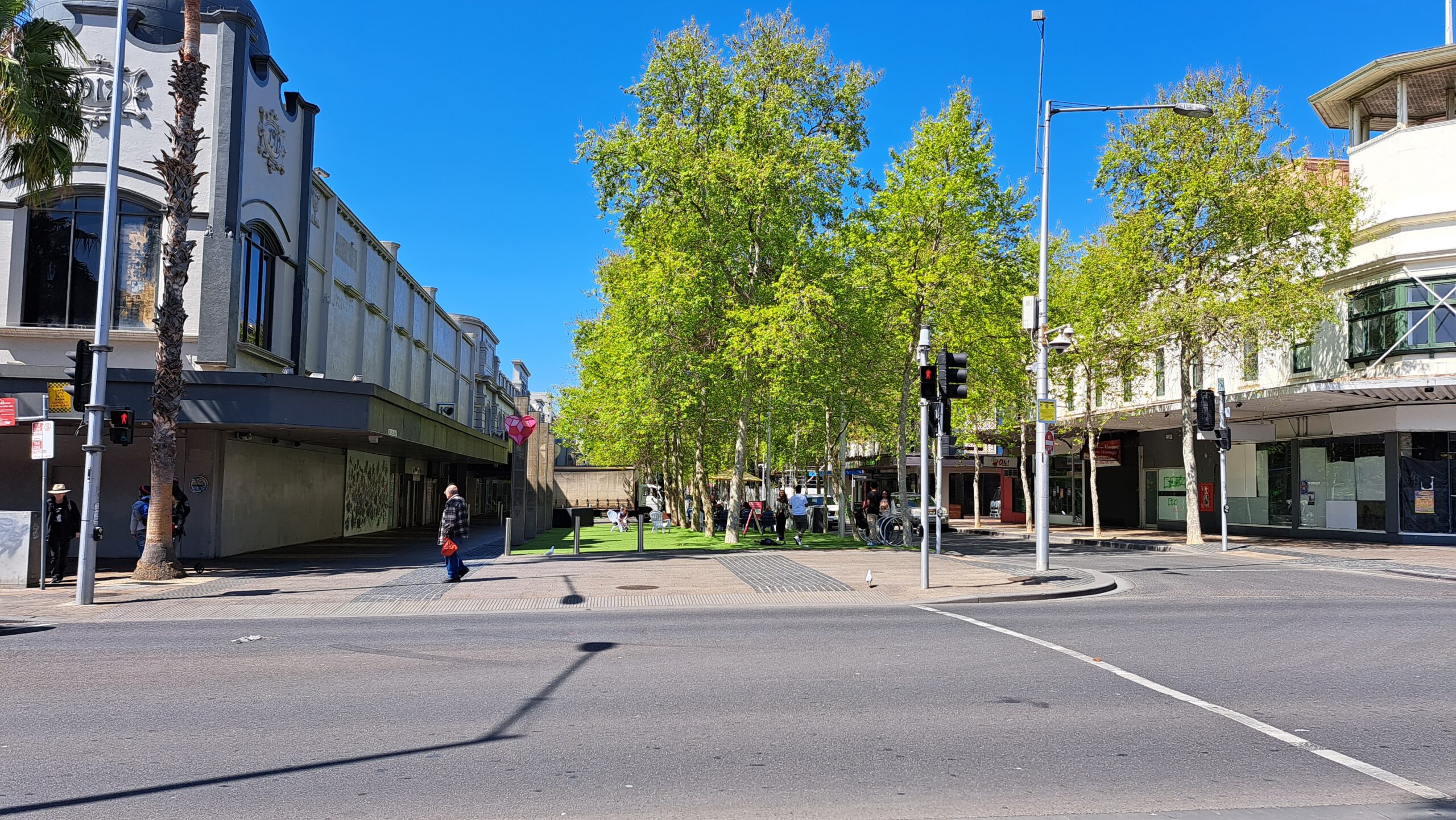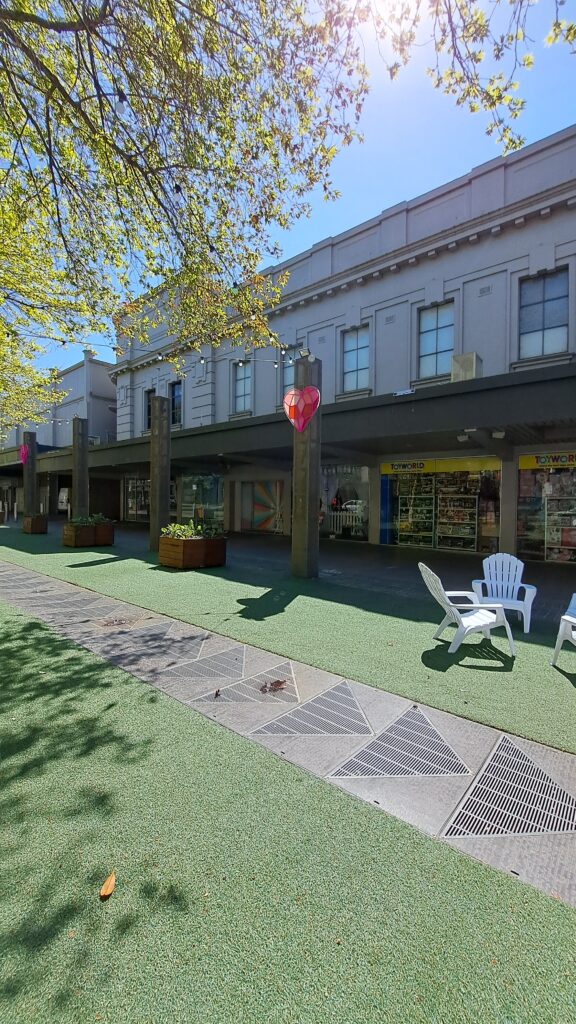
You look at the main street of Geelong and the bus stop that’s down there. Sorry, I don’t know street names. But you’ve always got people talking to themselves, drinking, smoking, yelling. There’s just kind of a sense of chaos around there. It’s just yeah, bit chaotic. I think the Geelong city kind of needs to target that area and create a better solution because it’s not safe and it could probably deter people from public transport and just attracts crime and stuff. I think Geelong could benefit from more community centres, a community garden or free classes. Just a safe place to relax. Like, at Headspace there’s a room where if you just want to sit down and charge your phone, you can. I don’t know what that’s kind of like around the rest of Geelong, but I think that could be really good. Yeah.
-Emilie
You walk through Geelong, especially the Mall and stuff, and it’s like a waste town. All these businesses and stuff are shutting down because the owners and stuff were too focused on profits and didn’t want to pay their workers and stuff, and they weren’t seeing enough of a revenue, or the smaller ones – as opposed to like 7-11 or something – they just could not simply afford to keep open because of the cost of living and inflation and everything. Everything’s just so expensive now that people can’t afford to live, and that’s my major concern.
-Carmen
Emilie and Carmen are two of the young people participating in our research project COVID-19 and Disadvantaged Young People’s Education and Employment Aspirations: A Longitudinal Study of Young People’s Transitions in Geelong. Across 2021, 2022 and 2023, young people have spoken frankly with us about the challenges they have faced living through a global pandemic, and their hopes, aspirations and concerns for their own futures and those of the world around them. Emilie suggests that ‘a sense of chaos’ pervades particular areas of the Geelong city centre, and Carmen describes the CBD as ‘like a waste town’. The picture that emerges from these descriptions is one of disorder and decay, and across a series of two blog posts, we will interrogate this picture in some detail. We will tell a story about Geelong’s Little Malop Street mall, and explore what it reveals about the status of public space in the 21st century, and the dynamics of social and economic inequality in the post-industrial city of Geelong.
The scene
The Little Malop Street mall is an area of public space in the heart of Geelong’s CBD. It is a space frequented by a range of social groups, and this is in large part due to its proximity to key amenities, including the city’s central bus interchange, and convenience store 7-11. In their study of the mall, architecture and built environment researchers Fiona Gray and Matt Novacevski (2015) suggest that the mall has had a troubled history since its establishment in the 1850s. As they highlight, in his 1955 History of Geelong and Corio Bay, historian Walter Brownhill wrote of Market Square that ‘no quarter of Geelong has been the subject of so much controversy, so much muddling and so much studied vandalism’. In initial land surveys of Geelong, town planners earmarked the area as the site for a town square, and for much of its history Market Square functioned as a produce market, before being progressively built upon. With the construction of the large, multistorey Market Square shopping centre on the site in 1985, the area of public space was significantly reduced, limited to what Gray and Novacevski accurately describe as a ‘long rectangular rump’ at the southern edge of the original square.
In recent decades, a small number of highly-publicised violent incidents have cast a pall over this public space, the stigma surrounding the mall completely out of proportion to its size. And this is not for want of efforts to redevelop and beautify the space on the part of Geelong City Council. Fiona Gray (2015) notes that, despite a $3.5 million makeover in 2001 that merited an Australian Institute of Landscape Architects Commendation award for civic design, the mall ‘has remained a spectacular failure as a people-oriented community asset’. This is because the design features of the mall send a rather confused message. While the architects of the mall’s makeover claimed that it would transform the space into a ‘vibrant community/retail precinct’ and encourage foot traffic, pedestrians entering the space are greeted with long, blank concrete walls, shuttered storefronts, security grilles and loading bays. Seating is offered in the form of cold, stainless steel benches, many of which are backless, a feature clearly intended to discourage rough sleepers from utilising the space. Overhead, the hulking edifice of the Market Square shopping complex casts a shadow that Gray and Novacevski note ‘extends more than 20 metres into the space at midday around the autumn equinox’. Underfoot, water intermittently bubbles up from fountains embedded in areas traversed by pedestrians. The effect of all these features is to create a hostile ambience that discourages people from lingering in this space. Gray and Novacevski write that ’devoid of soft edges, the Market Square mall feels inherently unsafe’.
The Geelong City Council established a roster of events and activities designed to ‘activate’ the mall, including school holiday events, live music, sidewalk sales and food trucks, and more recently, has attempted to soften the hard edges of the mall and enhance the visual appeal of the space to daytime users, through the addition of fake grass, bean bag cushions and other kitsch. Despite this, as Gray and Novacevski astutely note, ‘the area returns to a lifeless void’ when it is not being formally activated in these ways.

The mall has been the setting for a string of violent incidents in recent decades, assaults, stabbings and rapes among them. The refrain of local politicians and business leaders is that the stigma surrounding the mall has reached such a zenith that the only solution left is to demolish the mall. Particular vitriol has been directed towards the ‘mallrats’, those people who rely most heavily on the mall as a public space and who authorities view as undesirable types of people engaged in undesirable activities, such as drinking, smoking and ‘loitering’. In 2015, then-Mayor Darryn Lyons declared the mall a ‘haunt for bogans and scumbags’ (Pearson & Cannon 2015) and this kind of alarmist rhetoric is typical of that gracing the front page of local newspaper, the Geelong Advertiser, where it is joined by calls for increased ‘law and order’ measures in Geelong’s CBD. It is this bleak media narrative, in combination with the confused messages delivered by the physical characteristics of the mall’s built environment, that reinforce negative perceptions of the mall in the eyes of the public. Gray and Novacevski argue that ‘this feeds into a narrative of fear that becomes self-perpetuating. Memories and associations are formed that are difficult to shift and negative images stick’.
The ‘scene’
Contrast this gloomy scene with the ‘mall’ as it was known by people of my parents’ generation. Running perpendicular to Little Malop Street, McCann and Jacobs Streets were small streets situated in the space that would later be occupied by the Market Square Shopping Centre. Dotted by small shops and cafes, these narrow streets were the favoured hangout for working class young people. On the corner of Little Malop and Jacobs streets, Brash’s music store was a hive of activity on a Saturday morning, as young people headed in to buy a new record and linger for a while in the listening booths, sampling new releases. At other times, the destination was one of the movie theatres to catch a ‘flick’ or to the Golden Cue for a game of snooker.
Friday and Saturday nights were when the scene came alive. Those young people with access to four-wheeled transport would head into town to ‘do laps’ around Little Malop, McCann and Jacobs Streets. Yet, young people occupied this space largely without fear of violence. Although there were pubs in the vicinity, the cafes did not serve alcohol, and ‘anti-social’ activities were relatively rare. At the Kit Kat or Antoine’s café, for the price of a cheap toasted sandwich or a glass of watered-down coke, young people could while away the hours socialising with friends, or simply sit watching the cars go by. These kinds of relatively passive, non-commercial activities are no longer possible in this space. The Market Square shopping centre that replaced McCann and Jacobs Streets, like other shopping malls that were springing up across the world in the late 20th century, was an intense, labyrinthine environment, a space which constructed the people who moved through it as ‘consumers’. Through a variety of stimuli, much of them disorientating, the people inhabiting these spaces are continuously prodded towards consumption. And these spaces of consumerism were highly monitored spaces: every move of the ‘consumer’ catalogued by surveillance cameras.
Stay tuned for Part Two of this blog series, in which we will explore the ways in which local economic development actors have sought to ‘fix’ the Little Malop Street Mall in recent times – and the limitations of these approaches.
We acknowledge the Wadawurrung (or Wathaurung) people of the Kulin nation who are the traditional custodians of the unceded Country where this research has taken place. We respectfully recognise past, present and future Wadawurrung/Wathaurung Elders of the Kulin nation.
References
Gray, F. 2015. “The Misanthropes, Larrikins and Mallrats of Market Square: An Enduring Public Space Dilemma in Central Geelong.” In Proceedings of the Society of Architectural Historians, Australia and New Zealand: 32, Architecture, Institutions and Change, edited by Paul Hogben and Judith O’Callaghan, 218-230. Sydney: SAHANZ.
Gray, F & Novacevski, M 2015, ‘Unlawful acts, unkind architecture and unhelpful perceptions: a case study of Market Square Mall, Geelong’, paper presented to Safe Cities Conference, Melbourne, 8 July 2015.
Pearson, E. & Cannon, A. 2015, ‘Bash victim says she was helping a friend’, Geelong Advertiser, 20 January 2015, pp.4-5.
